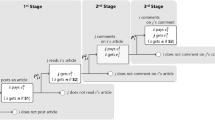Abstract
We propose an SNS-norms game to model behavioral strategies in social networking services (SNSs) and investigate the conditions required for the evolution of cooperation-dominant situations. SNSs such as Facebook and Google+ are indispensable social media for a variety of social communications ranging from personal chats to business and political campaigns, but we do not yet fully understand why they thrive and whether these currently popular SNSs will remain in the future. A number of studies have attempted to understand the conditions or mechanisms that keep social media thriving by using a meta-rewards game that is the dual form of a public goods game or by analyzing user roles. However, the meta-rewards game does not take into account the unique characteristics of current SNSs. Hence, in this work we propose an SNS-norms game that is an extension of Axelrod’s metanorms game, similar to meta-rewards games, but that considers the cost of commenting on an article and who is most likely to respond to it. We then experimentally investigated the conditions for a cooperation-dominant situation, by which we mean many users continuing to post articles on an SNS. Our results indicate that relatively large rewards compared to the cost of posting articles and comments are required to evolve cooperation-dominant situations, but optional responses with lower cost, such as “Like!” buttons, facilitate the evolution. This phenomenon is of interest because it is quite different from those shown in previous studies using meta-rewards games. We also confirmed the same phenomenon in an additional experiment using a network structure extracted from real-world SNS data.
Similar content being viewed by others
References
Axelrod R.: “An Evolutionary Approach to Norms,”. American Political Science Review 80(4), pp. 1095–1111 (1986)
Barabasi A. L., Albert R.: “Emergence of Scaling in Random Networks,”. Science 286(5439), pp. 509–512 (1999)
Easley, D. and Kleinberg, J., Networks, Crowds, and Markets: Reasoning About a Highly Connected World, Cambridge University Press, 2010.
Ghanem, A. G., Vedanarayanan, S. and Minai, A. A., “Agents of Influence in Social Networks,” in Proc. of the 11th Int. Conf. on Autonomous Agents and Multiagent Systems, 1, AAMAS ’12, pp. 551–558, Richland, SC, 2012.
Gonzalez, R., Cuevas, R., Motamedi, R., Rejaie, R. and Cuevas, A., “Google+ or Google- ?: Dissecting the Evolution of the New OSN in Its First Year,” in Proc. of the 22nd Int. Conf. on World Wide Web, WWW ’13, pp. 483–494, Switzerland, 2013.
Hirahara, Y., Toriumi, F. and Sugawara, T., “Evolution of Cooperation in Meta-Rewards Games on Networks of WS and BA Models,” in Proc. of the 2013 IEEE/WIC/ACM Int. Joint Conf.s on Web Intelligence (WI) and Intelligent Agent Technologies (IAT), 3, WI-IAT ’13, pp. 126–130, Washington, DC, USA, IEEE Computer Society, 2013.
Hirahara, Y., Toriumi, F. and Sugawara, T., “Evolution of Cooperation in SNS-norms Game on Complex Networks and Real Social Networks,” in Proc. of the 6 th Int. Conf. on Social Informatics (SocInfo2014), Barcelona, Spain, pp. 112–120, Springer, 2014.
Karamon, J., Matsuo, Y. and Ishizuka, M., “Generating Useful Network-based Features for Analyzing Social Networks,” in Proc. of the 23rd National Conf. on Artificial Intelligence, 2, AAAI’08, pp. 1162–1168, AAAI Press, 2008.
LINE, http://line.me/
Myers, S. A. and Leskovec, J., “The Bursty Dynamics of the Twitter Information Network,” in Proc. of the 23rd Int. Conf. on World Wide Web, WWW ’14, pp. 913–924, Republic and Canton of Geneva, Switzerland, 2014.
Newman M.: “The Structure and Function of Complex Networks,”. SIAM Review 45(2), pp. 167–256 (2003)
Stanford Large Network Dataset Collection, http://snap.stanford.edu/data/
Stieglitz S., Dang-Xuan L.: “Social media and political communication: a social media analytics framework,”. Social Network Analysis and Mining 3(4), pp. 1277–1291 (2013)
Takahashi T.: “MySpace or Mixi? Japanese engagement with SNS (social net-working sites) in the global age,”. New Media & Society 12(3), pp. 453–475 (2010)
Toriumi, F., Yamamoto, H. and Okada, I., “Why Do People Use Social Media? Agent-Based Simulation and Population Dynamics Analysis of the Evolution of Cooperation in Social Media,” in Proc. of The 2012 IEEE/WIC/ACM Int. Joint Conf. on Web Intelligence and Intelligent Agent Technology, 2, WI-IAT ’12, pp. 43–50, Washington, DC, USA, IEEE Computer Society, 2012.
Toriumi F., Yamamoto H., Okada I.: “Influence of Payoff in Meta-Rewards Game,”. Journal of Advanced Computational Intelligence and Intelligent Informatics 18(4), pp. 616–623 (2014)
Vázquez, A., “Growing network with local rules: Preferential attachment, clustering hierarchy, and degree correlations,” Phys. Rev. E, 67, p. 056104, 2003.
Watts D. J., Strogatz S. H.: “Collective dynamics of ‘small-world’ networks,”. Nature 393, pp. 440–442 (1998)
Author information
Authors and Affiliations
Corresponding author
Additional information
In association with The Japanese Society for Artificial Intelligence
About this article
Cite this article
Hirahara, Y., Toriumi, F. & Sugawara, T. Cooperation-dominant Situations in SNS-norms Game on Complex and Facebook Networks. New Gener. Comput. 34, 273–290 (2016). https://doi.org/10.1007/s00354-016-0305-z
Received:
Revised:
Published:
Issue Date:
DOI: https://doi.org/10.1007/s00354-016-0305-z




